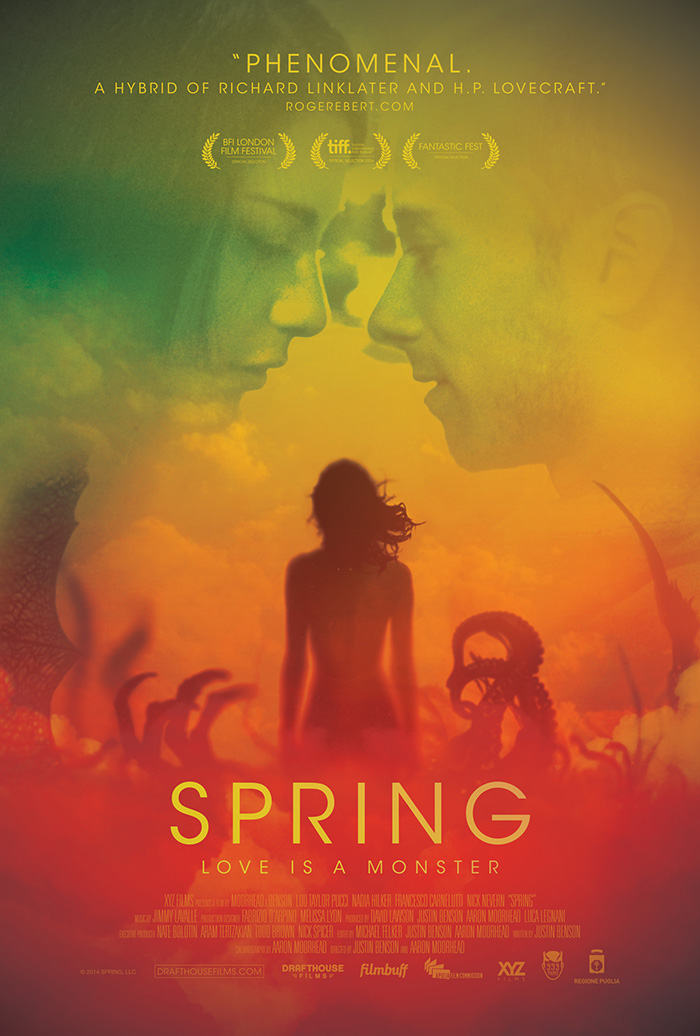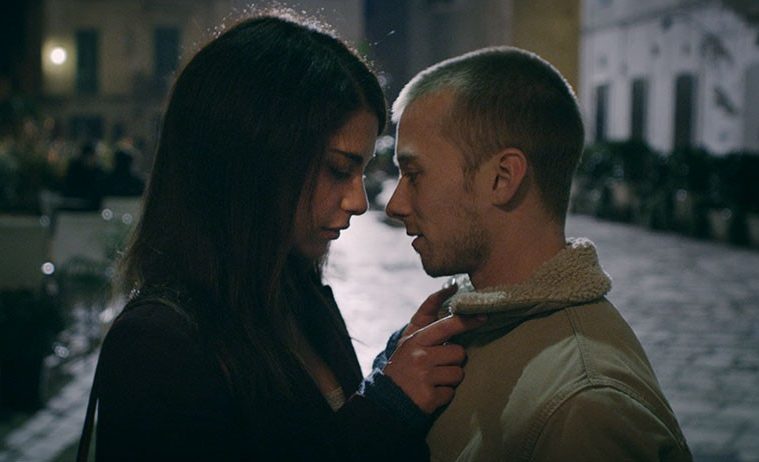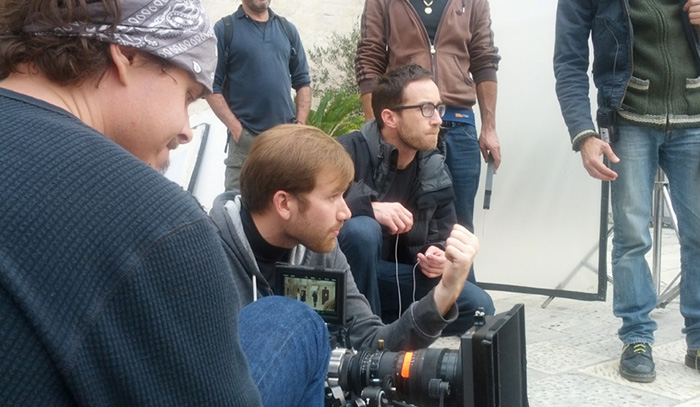
Sometimes the festival experience has a way of making you overrate films. The excitement of seeing things early with like-minded individuals, listening to filmmakers talk before and after their screenings, and the general festival aura are hard to separate from the work itself. So I won’t lie and say I didn’t re-watch Aaron Moorhead and Justin Benson‘s Spring—my favorite of TIFF 2014—with a little trepidation in case the memory proved grander than reality.
109 minutes later, however, I realized I might have actually underrated it. This supernatural, sci-fi, horror, romantic drama is the real deal and the latest example of how genre fare has taken the cinematic world by storm. Now with Drafthouse Films rolling it out in select theaters and FilmBuff pushing it on VOD platforms, audiences finally have a chance to see what’s quickly proving to be one of the best reviewed films of the year.
It was therefore my pleasure to talk with Moorhead and Benson about their sophomore effort, the current cinematic climate, and all the hard work necessary to get an independent production off the ground. The two are an entertaining pair that has really embraced social media to spark a dialogue with fans while also providing a unique level of transparency through the press to shed light on their process. Currently shooting a commercial as well as prepping both a new film and a television project, they’re graciously enjoying the ride as only artists with immense pride and faith in their work could.
**Warning for those who haven’t yet seen Spring, there are spoilers below.**
The Film Stage: How has it been working with Drafthouse Films?
Aaron Moorhead: They’ve been honestly everything you could ever hope for. It’s been amazing.
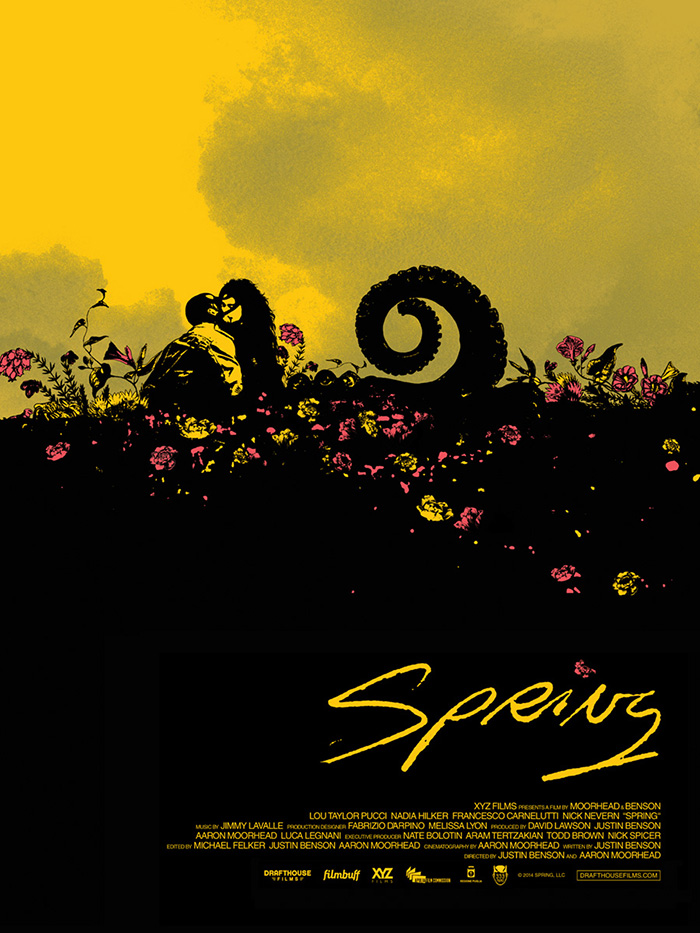 |
Did you see they released a Mondo poster today?
I did. Brandon Schaefer.
AM: It’s so, so, so beautiful. That’s kind of the dream, of course, as a filmmaker. And then they’ve kind of been taking all of our suggestions in a cool way and working really, really hard. But it’s still a very grassroots operation. We’re very, very heavily involved in it as well. It’s kind of this roughneck group—it’s really cool.
Justin Benson: Yeah. Publicity is me and Aaron and one publicist.
[Laughter]
There’s been a sort of Renaissance of independent film lately—genre work especially. What is your impression being on the inside? Is it just a matter of synergy between creative filmmakers, a younger critical sphere embracing them, and social media connecting both to a willing audience?
JB: An example—I’ve kind of never thought of this. But an example of Spring, It Follows, and The Babadook being around the same time. I genuinely have no idea why that is. In terms of a business standpoint, of getting a movie made and financed, we found that offering original content is like running up against a wall over and over. You can do it, but it’s so much easier to make a zombie movie. From a business standpoint it’s a no-brainer.
We don’t know what other people went through, but it’s definitely not a good gauge of the business climate or of the path of least resistance by any means. But it is really cool to see how audiences are embracing these movies that somehow snuck through—these very original, unique genre films. It’s really cool.
Do you see an establishment like The Academy evolving to embrace them as theatregoers have? There’s talk about going back to five Best Picture nominations since the experiment of using ten as a way to showcase movies like The Dark Knight have failed. Besides District 9 in 2009 and maybe Black Swan in 2010, the selections have been the usual suspects.
AM: I don’t personally see The Academy changing very much. I’m not one of the—there are a lot of people that raise their eyebrows at The Academy, “Oh they only like a certain thing”. Or that it’s corrupt or, “Oh they would never give that award to that.” It’s not a group of twelve evil people gathered around in a boardroom making these decisions. It’s a gigantic amount of people who vote.
So it’s not that The Academy guys don’t have the balls to do it. I think they serve one audience and genre films aren’t necessarily that audience. I don’t know if expanding from five films allows for genre or not, honestly.
What I heard was that it felt like the Academy Awards were stagnating and putting more horses in the race made it more interesting. I think that’s still a good thing. I don’t see what the problem is really. I don’t know why they’re considering going back down to five.
I think it’s more tagging onto the last question where it’s just more people consuming more movies in more ways. So it’s not going to be so dependent on, “What does The Academy say?” It’s always good to have something like an awards show, but it’s pretty cool [audiences are finding work outside that space].
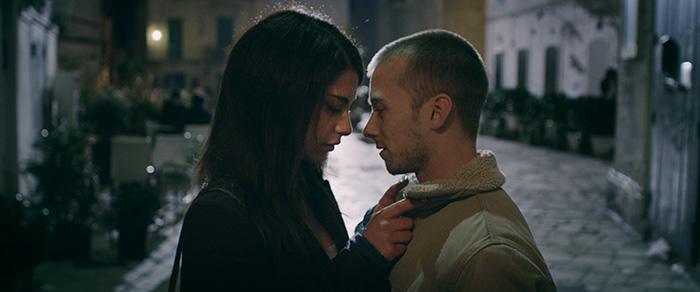
Both your films have had a refreshing subversion of expectations. In Resolution you have the character that should be unreliable as a junkie put in a position of trust by chaining him in place while the “sane” friend experiences unexplainable events. And with Spring you not only subvert supernatural horror for science fiction, but also the monster/human dynamic by shrouding someone like Angelo in a dark light with his many blades while Louise—who we should fear—has organic life blossoming in her wake. How do you approach storytelling to discover those avenues?
JB: I guess there’s always an interesting premise that could be almost like a Hollywood high-concept movie. You take that premise, but you make character first. You just embrace the fact that no matter how neat your concept is it has no impact without good characters. And you don’t have good characters without spending a lot of time with them being normal human beings and saying normal human being stuff. That’s a big part of the approach, I’d say. What about you Aaron?
AM: Yeah. Honestly, I completely agree.
In some ways subversion is the word, but subversion kind of implies an act. A thought of us kind of sitting down and being, “Alright, what are we tired of and let’s do something that uses that.” Our movies aren’t that reactionary. They are—often when we’re doing something that feels familiar we’ll just go the other way—but mostly it doesn’t stem from that. It stems from, “What story do we really want to tell and how’s the best way to tell it?”
The things you see in our movies are very instinctual to us. When we sit down to shot list or we sit down and script it out, everything makes perfect sense. It’s about how to get it across. Instinctual is the word I’m going to keep using, but it’s not quite the word I mean. It’s not something that would come to mind to everybody immediately.
JB: To add to that, something interesting too is the approach of following your instincts and following your gut and having that take precedence over traditional rules in writing and filmmaking. When I looked over, for example, the New York Times review for Spring—it’s a wonderful review, really positive. The thing they liked most about it was the sort of development ideology [the patience to wait an hour before revealing the big effect] that people wanted to change in Spring almost invariably. That’s the one reason they gave us a good review in the New York Times.
So there’s that too. I think a big part of our storytelling is that we know the rules, but we [also] know when to break them.
When you were at Cannes, riding your bikes around to pitch investors, did you only have a concept ready or the complete script?
AM: [We had] the whole script. We had the script and we had the success of Resolution. And that was roughly it. We kind of had this idea in our heads that Resolution did so well and a lot of people really liked it—it’s 100% on Rotten Tomatoes—all that. It should be relatively easy to get this next film off the ground. Man, it was not at all.
Our idea to go to Cannes wasn’t half-baked—it cost us a ton of money out of our personal bank accounts. It was definitely something where we were like, “Ok, this is how we’re going to do it to be worth it.” And it was.
The script was actually written while Resolution was being [completed]. And then at a certain point we decided—at the very beginning of 2014—I believe it was 2014 where we finally sat down and—oh, it was 2013. Wow. Yeah, it was the very beginning of 2013 when we said, “Alright, that’s the movie we’re making next.”
There’s nothing magical about it, but when Justin and I put all of our effort towards something and there’s two of us kind of pushing and pushing and pushing, it seems like—even against great resistance, which we had—we’re kind of able to find a way to get it done.
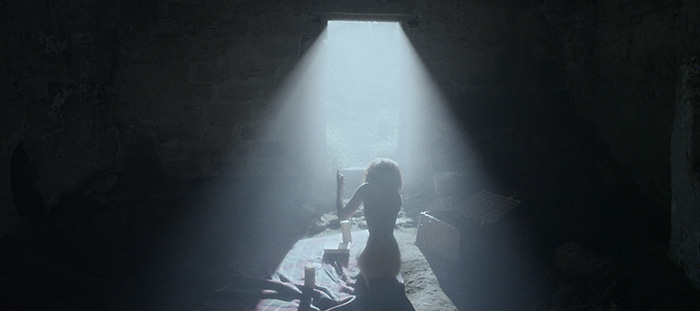
Were there any actual scientific theories serving as inspiration for what Louise is genetically or was it just a fun, intellectual way to get as many supernatural creatures onscreen as possible while still retaining an intimate dynamic between only two characters?
JB: Basically, Louise is possibly a skeleton key for all of the past movie monsters and mythology that we know from traditional horror films. So you see one part where you think she’s transforming into a werewolf, one where you think she’s a vampire, one where you’re, “Oh, she’s a Lovecraftian thing.”
It’s a soft touch, but as she suggests in the cathedral scene talking about her past, people have caught glimpses of her throughout the ages and she really is the single thing that was the inspiration behind our monster mythologies.
The thing I think that is more prominently explained is that all of those things can be linked to our evolutionary pasts. You could look at a diagram of us evolving from single-cell organisms to what we are now—it’s over-simplified and doesn’t make sense entirely, but that’s the idea behind her transformations.
When you see her growing big ol’ teeth and her facial structure changes, it’s not that she’s actually turning into a werewolf—though that’s the red herring. You find out later once you put it all together that, “Oh, no, no, no.” When she gets pregnant, which has already happened by that point of the story—her body goes haywire and turns into these creatures from our evolutionary past. And that part you’re seeing is something like a primate.
How was it to actually be able to show those effects? With Resolution, budget constraints and thematic reasons kept its entity off-screen completely. Was it fun to dig into that aspect here?
AM: The world of prosthetic creature effects is one we were pretty damn excited to jump into. It’s kind of a filmmaker’s dream. Every filmmaker has grown up with creature effects as part of their childhood movie diet. But that said, besides being an art it’s also an extraordinarily complicated craft. Luckily we had the opportunity to, more than a few times, start honing that. But of course with Spring being our first time, it wasn’t just one monster but many representations. We got to kind of get our hands into every single one of them. So we had lots of long conversations with Masters FX, our creature effects company, and we kind of developed something that appeared to be nature-based rather than off of a previous movie monster.
There were still a lot of—both for budgetary and story reasons—still a lot of keeping things close to the vest. Of suggesting rather than showing in the film. What’s kind of nice about that is that it has a similar effect to what everyone talks about with Jaws. The shark didn’t work, meaning we didn’t see very much of the shark, which actually gives it a better psychological impact. Our effects worked 100%, but we still decided on that same ethos. Show a little bit less until we have to show everything. And then we really only get to see everything everything [once] we understand everything everything at the same exact moment that our lead character does.
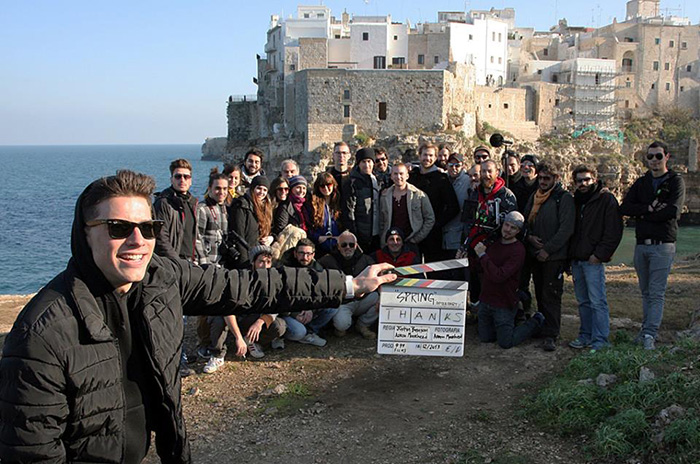
One of my favorite scenes is the long-take after Evan sees the “real” Louise and you track them walking through dark alleyways into an open square housing the payphone he uses to call home. Were you two kids in a candy store realizing the potential of these gorgeous Italian locales?
JB: That was a case of the scene preceding the candy a little bit. It was basically—we had written in the script that that would be the single-take scene for the story dynamic. But when we got there and saw all these alleyways that hit dead-ends, that’s when we decided immediately, “Oh, let’s have—if they hit dead-ends in their argument, let’s have them hit dead-ends literally.”
There were a couple different alleyways we could have done it in, but we went with that one because we could get—when you’re doing a shot like that you have the Steadicam, the sound guy, the director, the guy pulling focus. You have all these things and you have to figure out the best way to get it done. That was a nice discovery. That was fun.
What was the experience like being abroad?
AM: The location itself—the town kind of threw their doors open to us. Everywhere you point the camera in that town is pretty, so you get away with murder. Just aesthetically, you can’t lose.
We all stayed in that little town. We all walked to set everyday—every time we shot in the town. Which made everything extraordinarily easy, but also made it kind of feel like summer camp. Everybody was so cool and they were all kind of our friends at the end. Besides doing a lot of good, hard work and making the film happen, we got to eat together and drink together and go out to the one bar in the whole town together. The food is as good as you can ever hope and they shove so much of it down your throat that you come back feeling really fat.
Honestly, it was just as much fun as it looks. There are no real war stories. There’s a few, but you can’t complain. It would be weird to tell you a war story because everything was so wonderful.
You have numerous close-ups of creatures—dead and alive—in the transitions along the journey. Were they all things you saw in the wilderness or was a lot of it meticulously placed? Should I pay close attention the next time I watch to see parallels with Louise’s current form?
JB: There’s some visual connection sort of with what she’s turning into and those things, but there’s not much precision there. It all goes back to the film being nature-based. The insects in particular primarily serve two functions. Number One is to drive our theme of rebirth further along visually and Number Two is just to make people feel a little unnerved.
Also too, before you know what Louise is, it’s all sort of visual foreshadowing because it’s scary nature-based stuff. Worms are scary and animals decomposing are scary and scorpions are scary. That was basically it.
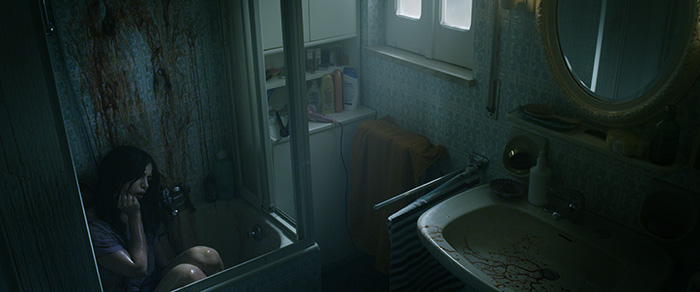
A lot of people are comparing Spring to Richard Linklater’s Before Trilogy with good reason. Those were very collaborative projects between filmmaker and performers to find that authenticity onscreen. You accomplished it also. Was there a lot of collaboration with Lou Taylor Pucci and Nadia Hilker or was everything pretty faithful to the script?
AM: Both actually. I think both is the answer.
The script is the words coming out of their mouths as you see them for the most part, even before we met them. But, when we met with Lou and Nadia, we just sat down with them individually and took an entire day—first to get to know each other—and also to page-by-page pour through the script and talk about what everything is and why and how. They both came back with some things that inspired some changes in the script.
And then we always spend a lot of time in rehearsal. And you find little magic moments in rehearsal or a joke or something that makes them seem even more human. We don’t say, “Say those words exactly.” They should say the words close, but they’ve got to make them their own. But there wasn’t anything really improvised or deliberately reworded or anything like that.
That’s patting both Justin’s script and the actors on the back for making it seem so fresh. But I think one of the biggest things besides having good dialogue in your script and having really talented performers is the time spent in rehearsals getting it dialed in. Then the time between the rehearsal and actually shooting it, there’s some cool-off time so it doesn’t feel like they’re just coming off of repeating those words.
How did you connect with the supporting cast like Angelo and the two friends Evan meets upon first arriving in Italy? Was it just casting calls?
JB: Thomas (Nick Nevern), the really chatty Englishman, he was one of the more difficult ones to find. We found him through our friend Matthias Hoene—who directed Cockneys vs Zombies—as a recommendation. He was exactly what we wanted for that role.
You have it in your head—you have this guy go to a really idyllic tourist place in Italy and all this stuff is happening and there’s something really fun about bringing in some grit from the other side of the Atlantic. Someone you don’t typically think about: the urban UK hooligan guy. It’s fun. It’s a fun voice to have in the movie. It’s unexpected and it makes it feel extremely real.
And then with Angelo (Francesco Carnelutti), that was the easiest casting in the world. They gave us like six choices and we were just looking at them and we’re like, “That guy.” We talked to him once on Skype from Rome. There weren’t even that many options on Angelo, but [Carnelutti] is someone who everyone universally admires his work.
AM: Yeah, he was perfect. It was pretty cool.
Is there anything you can tell us about what’s next? Any little hints?
AM: There aren’t any real hints, honestly. We can just tell you.
We’re pretty in-depth with a project about Aleister Crowley. We’re kind of telling a contained biopic story about him. About his transformation from kind of this guy who was very eccentric, very interesting kind of Tyler Durden meets Captain Jack Sparrow sort of guy—there are a lot of really great ideas and ideals—and what transformed him into what he’s remembered as, which is the press calling him the “wickedest man in the world”. That’s that movie.
And we’re also taking a TV show around. That’s just now getting going, but it seems pretty exciting. They’re both really, really exciting. The TV show in a nutshell is kind of like Almost Famous meets Lost.
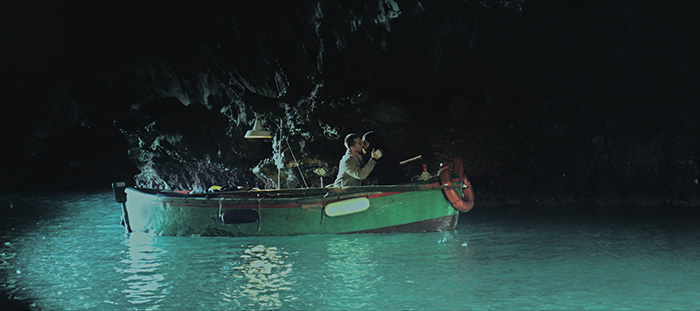
I appreciate you taking the time after what was probably a long day with the commercial.
AM: No problem. It was pretty much us sitting in an office and saying “Yes” and “No” a lot.
JB: And as long as we get to end the day talking about ourselves and the things we’ve done—Aaron is totally okay with it.
It’s just when it’s like, “Hey, want to talk about something that will benefit the world?” And he’s like, “Ugh!”
AM: Yeah: “Talk about the problems we’re having in Africa.” [Jokingly] No, I’m not going to talk about that at all. I’ve never been there.
[Laughter]
Well that’s good. You’ll sleep easy tonight then.
AM: Yeah, except for the nightmares about talking about something that’s not myself.
JB: He wakes up screaming when you’re traveling with him. We’ll be staying at the Holiday Inn and he’ll be, “Ahhhh!! I had it again!”
[Laughter]
JB: Can we talk about ourselves some more with you?
I guess one more thing. Any plans with Spring from Drafthouse that we should be looking out for?
JB: We’ve heard the Blu-Ray is a work of—they may instead of having Bibles in hotel rooms, put the Blu-Ray of Spring. It’s profound I guess. It’s going to have so much good stuff on it. We jumped the gun a bit on the publicity, but it’s coming.
AM: The problems in Africa are actually caused by the lack of this Blu-Ray. It’s like a finite resource. Like water. And we’re working on fixing it. Don’t worry.
Spring is currently in limited release and now available on VOD.
